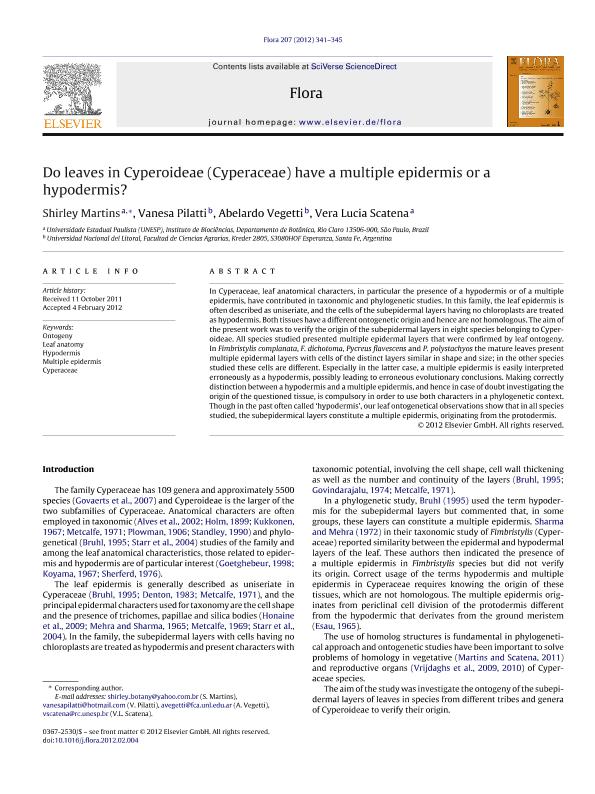Mostrar el registro sencillo del ítem
dc.contributor.author
Martins, Shirley
dc.contributor.author
Pilatti, Vanesa

dc.contributor.author
Vegetti, Abelardo Carlos

dc.contributor.author
Scatena, Vera Lucia
dc.date.available
2019-09-29T15:33:36Z
dc.date.issued
2012-05
dc.identifier.citation
Martins, Shirley; Pilatti, Vanesa; Vegetti, Abelardo Carlos; Scatena, Vera Lucia; Do leaves in Cyperoideae (Cyperaceae) have a multiple epidermis or a hypodermis?; Elsevier Gmbh; Flora; 207; 5; 5-2012; 341-345
dc.identifier.issn
0367-2530
dc.identifier.uri
http://hdl.handle.net/11336/84774
dc.description.abstract
In Cyperaceae, leaf anatomical characters, in particular the presence of a hypodermis or of a multiple epidermis, have contributed in taxonomic and phylogenetic studies. In this family, the leaf epidermis is often described as uniseriate, and the cells of the subepidermal layers having no chloroplasts are treated as hypodermis. Both tissues have a different ontogenetic origin and hence are not homologous. The aim of the present work was to verify the origin of the subepidermal layers in eight species belonging to Cyperoideae. All species studied presented multiple epidermal layers that were confirmed by leaf ontogeny. In Fimbristylis complanata, F. dichotoma, Pycreus flavescens and P. polystachyos the mature leaves present multiple epidermal layers with cells of the distinct layers similar in shape and size; in the other species studied these cells are different. Especially in the latter case, a multiple epidermis is easily interpreted erroneously as a hypodermis, possibly leading to erroneous evolutionary conclusions. Making correctly distinction between a hypodermis and a multiple epidermis, and hence in case of doubt investigating the origin of the questioned tissue, is compulsory in order to use both characters in a phylogenetic context. Though in the past often called ‘hypodermis’, our leaf ontogenetical observations show that in all species studied, the subepidermical layers constitute a multiple epidermis, originating from the protodermis.
dc.format
application/pdf
dc.language.iso
eng
dc.publisher
Elsevier Gmbh

dc.rights
info:eu-repo/semantics/openAccess
dc.rights.uri
https://creativecommons.org/licenses/by-nc-sa/2.5/ar/
dc.subject
Ontogeny
dc.subject
leaf anatomy
dc.subject
hypodermis
dc.subject
multiple epidermis
dc.subject
Cyperaceae
dc.subject.classification
Ciencias de las Plantas, Botánica

dc.subject.classification
Ciencias Biológicas

dc.subject.classification
CIENCIAS NATURALES Y EXACTAS

dc.title
Do leaves in Cyperoideae (Cyperaceae) have a multiple epidermis or a hypodermis?
dc.type
info:eu-repo/semantics/article
dc.type
info:ar-repo/semantics/artículo
dc.type
info:eu-repo/semantics/publishedVersion
dc.date.updated
2019-09-27T14:14:57Z
dc.journal.volume
207
dc.journal.number
5
dc.journal.pagination
341-345
dc.journal.pais
Alemania

dc.description.fil
Fil: Martins, Shirley. Universidade Estadual Paulista Julio de Mesquita Filho; Brasil
dc.description.fil
Fil: Pilatti, Vanesa. Consejo Nacional de Investigaciones Científicas y Técnicas. Centro Científico Tecnológico Conicet - Santa Fe. Instituto de Agrobiotecnología del Litoral. Universidad Nacional del Litoral. Instituto de Agrobiotecnología del Litoral; Argentina
dc.description.fil
Fil: Vegetti, Abelardo Carlos. Consejo Nacional de Investigaciones Científicas y Técnicas. Centro Científico Tecnológico Conicet - Santa Fe. Instituto de Agrobiotecnología del Litoral. Universidad Nacional del Litoral. Instituto de Agrobiotecnología del Litoral; Argentina
dc.description.fil
Fil: Scatena, Vera Lucia. Instituto de Biociencias; Brasil
dc.journal.title
Flora

dc.relation.alternativeid
info:eu-repo/semantics/altIdentifier/doi/http://dx.doi.org/10.1016/j.flora.2012.02.004
dc.relation.alternativeid
info:eu-repo/semantics/altIdentifier/url/https://www.sciencedirect.com/science/article/abs/pii/S0367253012000370
Archivos asociados
